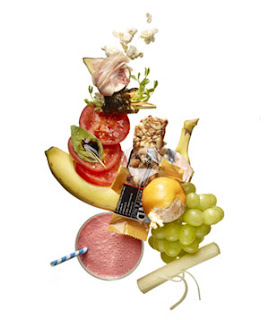One of the most annoying parts about trying to eat healthy food in college is that there aren't a whole lot of things you can do with the cooking tools you can have in your dorm room. Here are a few healthy snacks that you can make with nothing but a hot pot, a microwave, and a toaster.
1. Bagels with cream cheese. This one's pretty obvious, and it's easy if you can have a toaster in your room. If you don't have a toaster with extra-wide slots, pick up the miniature bagels that will fit in a regular toaster. Try flavoring your cream cheese yourself with honey or cinnamon.
2. Hard-boiled eggs. These are really healthy snacks when you need some protein to stick with you through a boring afternoon class. All you have to do is use your hot pot and put the raw eggs in gently when the water is boiling. You may want to slide a couple of eggs into a plastic bag first to control the mess if the eggs crack open before they're done.
3. Oatmeal. This is a great snack when you have a carb craving, especially if you use the old-fashioned oats, which are a whole grain full of nutrients like iron. You can microwave even old-fashioned oatmeal. For a fruity kick, make it with apple cider instead of water, or make it with milk for a creamier flavor.
4. Trail mix. Buying actual trail mix can be pretty expensive, but you can buy nuts and dried fruit in bulk and mix up your own trail mix with the ingredients you like the most. If you need a treat, add some dark chocolate chips to the mix.
5. Ants on a Log. This fantastic elementary school snack is a good combination of fiber, protein, and carbs. Spread some peanut butter on a celery stick, and top it with a few raisins for ants.
6. Pita pizzas. This one is a little more complex, but it's still easy to do in your dorm room. Stock your fridge with a small jar of spaghetti sauce, some chopped pizza veggies, and some Italian-style shredded cheese. Spread your sauce on a whole wheat pita, add veggies and cheese, and nuke it for about a minute.
7. Roll ups. You can make a roll up out of just about anything. Lunch meat is a cheap option for adding protein to your diet. Spread some hummus or whatever else you like on a piece of lunch meat, roll it up into a cigar shape, and enjoy!
8. Pudding. When you need some satisfaction for your sweet tooth, grab some pudding packets from the grocery store and make your own pudding. The low sugar varieties don't have too many calories in them, and all you need is a bit of milk to mix up your own dorm room dessert.
These are all snacks that involve a bit of "putting-together," but you can keep a lot of other snacks in your room that don't need any work on your part. Pick up good cereals, whole pieces of fruit, veggies, and jerky for your dorm room so that you have a satisfying snack whenever you need one.
Crystal is the owner of GreekForMe - a fraternity and sorority Greek merchandise store that features licensed Chi Omega merchandise.
In her free time, she volunteers at her kids' school and also actively supports Relay for Life for the American Cancer Society.
In her free time, she volunteers at her kids' school and also actively supports Relay for Life for the American Cancer Society.






















